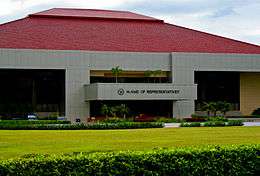Batasang Pambansa
The Batasang Pambansâ (often referred to simply as just the Batasan; English: National Assembly, literally "National Legislature") was the former parliament of the Philippines, established as an interim assembly in 1978 and later as an official body in 1984. It was the second unicameral parliament in Philippine history, the first being the 1899 National Assembly of Representatives. Members of the Batasang Pambansâ were referred to as "Mambabatas Pambansâ," (English: Member of Parliament, literally "national lawmaker"), shortened to "MP," similar to the Westminster system.
The Batasan was instituted under the 1973 Constitution promulgated by then-President Ferdinand Marcos, replacing the earlier Congress of the Philippines established by the 1935 Commonwealth Constitution. It was abolished immediately after the People Power Revolution in 1986, and Congress was restored with the passage of the 1987 Constitution.
History
The original provisions of the 1973 Constitution, which was ratified on 17 January 1973, provided for the establishment of a unicameral National Assembly. Upon its ratification, an interim National Assembly composed of the President and Vice President of the Philippines, those who served as President of the 1971 Constitutional Convention, the Members of the Senate and the House of Representatives, and those Delegates to the 1971 Constitutional Convention, was established and functioned as the Legislature.
However, the regular National Assembly under the 1973 Constitution was not convened. By virtue of Presidential Decree No. 1033 (the 1976 Amendments to the Constitution) the National Assembly was replaced by the Interim Batasang Pambansa which carried all the powers inherent from the dissolved body. Members of the Regular Batasang Pambansa included regional representatives, sectoral representatives, and members of the Cabinet chosen by the incumbent President.
Before the Regular Batasang Pambansa convened, the 120-member Interim Batasan served as the national Legislature. The body was composed of the incumbent President, representatives elected from different regions and from different sectors, and select Cabinet officials appointed by the President. In 1981, the semi-parliament was formally convened as the "Batasang Pambansa", and in 1984, some dissident members unsuccessfully tried to impeach President Marcos.
The Batasang Pambansa was subsequently dissolved when Proclamation No. 3, popularly known as the 1986 Freedom Constitution, was promulgated on 25 March 1986.



